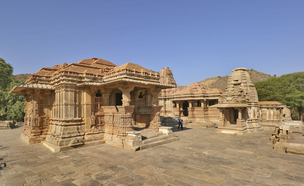
The twin Sas-Bahu temples were built around 975 CE. Nagada has been the capital of the Guhila rulers for a long time and was known as Nagahrida in the past. Both these small structures have simple sanctum walls but the mandapas show a taste of profuse ornamentation. The sanctums of these temples are of panchratha type.
The twin Vaishnava temple complex originally known as Sahastrabahu now called as Sas-Bahu temples raised on a molded platform is entered through a detached makara torana on the east. The larger one (Sas temple) is surrounded by subsidiary shrines and, consists of a pancharatha sanctum and antarala (Vestibule), a gudhamandapa (closed hall) and an entry porch. The podium moldings of the sanctum are adequate but undammed while the smaller one (Bahu temple) is a five shrine complex. The relief figures include male and female deities, damsels, regents, amorous panels and scenes from the Ramayana. The pillars, ceilings, architraves and door frames are of a highly developed design and lavishly ornamented. The entry to these structures is through a detached torana which might have been taken from Ghateshwara temple of Badoli. The larger temple stands surrounded by ten small shrines while the smaller temple has four subsidiary shrines on four corners and belongs to panchayatana style. The sanctums of both these temples are of panchratha type. They have vestibule, closed hall with lateral transepts and a porch enclosed by a balustrade as other parts of the temple. A grassmukhas band divides the wall in two parts which are unadorned and simple. There are images of Brahma, Shiva and Vishnu on the cardinal off-sets topped respectively by images of Ram, Balarama and Parsurama. The brick- made shikhara which has sustained minor damage is adorned with a group of minor turrets.
The elaborated ornamentation of the transepts of the closed hall as well as the interior and exterior parts of the porch is in contrast with the plain and unadorned walls of the sanctum and the vestibule. There are developed images of god and goddesses in relief, together with the icon of the four- armed Regents. Erotic figures are also found here. Apsaras, Friezes and the scenes from Ramayana adorn the walls of the temple. The pillars, architraves, door-frames are of developed type and have profuse ornamentation in relief.
Both these temples are similar in construction but there are a few differences in details. The closed hall of the larger temple has four central pillars having makaratoranas on them .The smaller temple has a mandapa with octagonal ceiling. The vital differences lies in the fact that the former temple has ornamented latticed windows of the transepts of the closed hall while the smaller one has lateral porches. The larger temple is more ornamented in comparison with the smaller one.
There is an icon of Seshashayi Vishnu outside the temple of Bahu. Astamatrika figures are found on the entablatures of the pillars while some dancing figures adorn the ceiling. The icons of gods like Brahma, Vishnu and Shiva adorn the niches made in the wall. The temple of Sas is bigger in size and has better decoration. A loose piece of stone shows a male figure with a pot in both hands. Such figure is also noticed on the Bahu temple. These two temples belong to the same period and are contemporary, belonging to late 10th century CE.